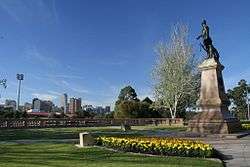Light's Vision
Coordinates: 34°54′46″S 138°35′38″E / 34.9128°S 138.5940°E

The first surveyor-general of Adelaide, South Australia, Colonel William Light designed a layout and development programme for the city. This plan is now known as "Light's Vision". Notable aspects of Light's plan are that the city centre is laid out in a grid-like pattern, with squares in the centre of the city and in the centres of the four quarters of the city, (NW, NE, SE, SW), and the city is surrounded by Parklands.
Light's Vision commemoration
Light's work was acknowledged by the "Light's Vision commemoration" statue, by Glaswegian sculptor Birnie Rhind, which was unveiled in the northwest of Victoria Square (opposite the GPO) on 27 November 1906.[1]
Legend has it that William Light stood on Montefiore Hill (in the North Parklands adjacent to North Adelaide) in 1837, pointed at what would one day become the Adelaide city centre, and said "This is the place for a city". The statue was moved from Victoria Square to Montefiore Hill in 1938. Since then, the statue has depicted Light pointing at the City of Adelaide below. With the passage of time, the commemorative statue, and the piece of land on which it stands, have both come to be referred to as "Light's Vision", rather than the official full name "Light's Vision commemoration".
However, there is evidence that the declaration was made from a lower hill near the corner of North Terrace and West Terrace,[2] and there is a plaque placed in that vicinity by the Adelaide City Council in 1928.[3]
Behind the statue (north and north-east) is Aquinas College, which is affiliated with the University of Adelaide. To the north-west is Carclew. In front of the statue are parklands which include the Adelaide Oval and Memorial Drive, and, of course, a view over the Adelaide city centre which is the realisation of "Light's Vision".
Montefiore Hill
- Montefiore Hill redirects here
Montefiore Hill is a small hill in North Adelaide, South Australia, named after Jacob Montefiore, a Jewish Colonising Commissioner who was a cousin of the British philanthropist, Moses Montefiore. It offers a vantage point over Adelaide Oval, Memorial Drive Tennis Courts, the northern sections of the Adelaide Parklands, and the Adelaide city centre.
History
Light's decision on Adelaide's location was initially unpopular among the settlers, foremost with South Australia's first governor, John Hindmarsh, but Light and the resident commissioner James Hurtle Fisher were empowered to decide the location of the colony's first city. Hindmarsh, a maritime hero (Battle of the Nile) was fixated on Encounter Bay on the basis of it being the location of the mouth of the River Murray, and the inland river transport anticipated. Hindmarsh was recalled to London to answer charges of misconduct, George Gawler replacing him.
The indecision caused by the dispute over the final location of the capital created uncertainty and a long delay in the survey of country sections. This, and an early property boom in the Adelaide Square Mile damaged the cashflow of the settlement which was found to be officially bankrupt after Gawler invested heavily in town development, including the generously proportioned Adelaide Gaol.
References
- ↑ The Colonel Light Statue - Unveiling Ceremony - An immense gathering., Adelaide Advertiser, Wednesday 28 November 1906, pg.7. (via trove.nla.gov.au)
- ↑ Location of "Light's Vision" disputed. Adelaide Review, July 2004.
- ↑ Monument and plaque near the corner of North & West Terraces.
(Due to construction of the new Royal Adelaide Hospital, this monument is not currently (2013) visible to the public.)